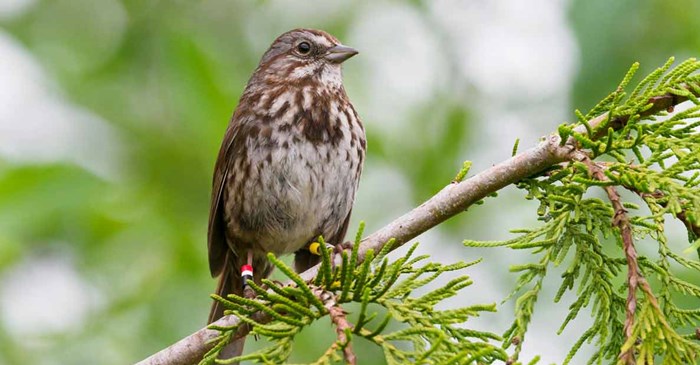While you’re keeping an eye on the feeders, there’s one little detail you’ll want to watch for. Is that bird wearing what appears to be a little silver bracelet on its leg? Or maybe he’s sporting some colored leg bands? If so, you’re looking at a banded bird, and you’ll want to go online to reportband.gov and report your findings. The information you share will help a scientist with their research.
Tracking banded birds in North America is jointly administered by the U.S. Fish and Wildlife Service and the U.S. Geological Survey and Canadian Wildlife Survey. At some point in the bird’s life, the bird was caught, most likely after flying into a lightweight mist net. Then a trained scientist carefully and safely retrieved it from the net, weighed and measured it, and collected other details to determine the bird’s species, age and health.
Finally, they carefully fastened a small aluminum band stamped with a code around the bird’s leg before it was released back into the wild. (Sometimes, instead of a metal band, scientists opt for a series of color-coded plastic bands because it’s an easier way to ID live birds.) To see this in action, watch this video from the Bird Conservatory of the Rockies.
Why do researchers capture and band birds? Bird banding is one method to help scientists track bird migration and population. When they perceive changes in these two areas, that can signal environmental changes, whether they’re driven by climate or habitat.
So you found a banded bird. Now what?
If you find a songbird sporting hardware (or water fowl wearing a collar band, or raptors) there’s an online form to fill out. Before you do, here’s what you need to know:
- First, take note of any details about your find: species, the bird’s location, date and time of day, and how you found the bird.
- If it’s a live bird, do your best to get the number from the metal band. This can be challenging and you may need to use binoculars or a spotting scope to get that up-close look. On the other hand, if the bird is wearing colored leg bands, note the colors and their placement.
And that’s it! For your trouble, they’ll share details of when and where your bird was originally banded, and you’ll receive a certificate of appreciation.
If you happen to be lucky enough to see one of these banded birds, be sure and report the sightings. You’ll be doing your part to support important bird research.
What's another way to support birds? Keep your feeders filled with a high-quality, nutritious mix. Lyric Supreme Mix contains more than 50% sunflower seeds and nuts, which will bring a wide variety of colorful birds in for a landing.
